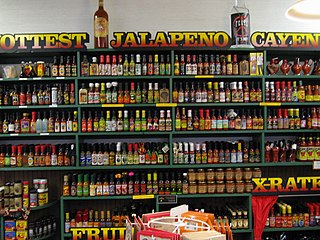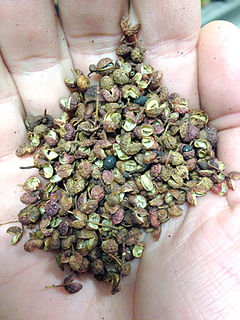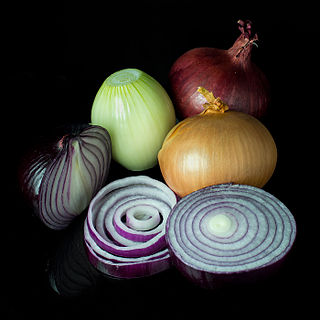
Mexican cuisine began about 9,000 years ago, when agricultural communities such as the Maya formed, domesticating maize, creating the standard process of corn nixtamalization, and establishing their foodways. Successive waves of other Mesoamerican groups brought with them their own cooking methods. These included the Olmec, Teotihuacanos, Toltec, Huastec, Zapotec, Mixtec, Otomi, Purépecha, Totonac, Mazatec, and Mazahua.

The Scoville scale is a measurement of the pungency of chili peppers and other spicy foods, as recorded in Scoville Heat Units (SHU) based on the concentration of capsaicinoids, among which capsaicin is the predominant component. The scale is named after its creator, American pharmacist Wilbur Scoville, whose 1912 method is known as the Scoville organoleptic test. In the 21st century, high-performance liquid chromatography (HPLC) is used to quantify the capsaicinoid content as an indicator of pungency. The most expedient method for estimating SHU is a subjective assessment derived from the capsaicinoid sensitivity by people experienced with eating hot chilis.

The chili pepper, from Nahuatl chīlli, is the fruit of plants from the genus Capsicum which are members of the nightshade family, Solanaceae. Chili peppers are widely used in many cuisines as a spice to add heat to dishes. The substances that give chili peppers their intensity when ingested or applied topically are capsaicin and related compounds known as capsaicinoids.

Black pepper is a flowering vine in the family Piperaceae, cultivated for its fruit, known as a peppercorn, which is usually dried and used as a spice and seasoning. When fresh and fully mature, it is about 5 mm (0.20 in) in diameter and dark red, and contains a single seed, like all drupes. Peppercorns and the ground pepper derived from them may be described simply as pepper, or more precisely as black pepper, green pepper, or white pepper.

Scotch bonnet, also known as bonney peppers, or Caribbean red peppers, is a variety of chili pepper named for its resemblance to a tam o' shanter hat. It is native to the Caribbean islands and Central America. Most Scotch bonnets have a heat rating of 80,000–400,000 Scoville units. For comparison, most jalapeño peppers have a heat rating of 2,500 to 8,000 on the Scoville scale. However, completely sweet varieties of Scotch bonnet are grown on some of the Caribbean islands, called cachucha peppers.

Salsa is any one of several sauces typical of Mexican cuisine, also known as salsa fresca, hot salsa or salsa picante, particularly those used as dips. Salsa is often tomato-based, and includes ingredients such as onions, chilies, an acid and herbs. It is typically piquant, ranging from mild to extremely hot. Though many different sauce preparations are called salsa in Spanish, in English, it generally refers to raw or near-raw sauces used as dips.

Chili powder is the dried, pulverized fruit of one or more varieties of chili pepper, sometimes with the addition of other spices. It is used as a spice to add pungency or piquancy and flavor to dishes. In American English, the name is usually spelled "chili". In British English the spelling "chilli" is used consistently.

Hot sauce, also known as chili sauce or pepper sauce, is any condiment, seasoning, or salsa made from chili peppers and other ingredients.

Capsicum annuum is a species of the plant genus Capsicum (peppers) native to southern North America and northern South America. This species is the most common and extensively cultivated of the five domesticated capsicums. The species encompasses a wide variety of shapes and sizes of peppers, both mild and hot, such as bell peppers, jalapeños, New Mexico chile, and cayenne peppers. Cultivars descended from the wild American bird pepper are still found in warmer regions of the Americas. In the past, some woody forms of this species have been called C. frutescens, but the features that were used to distinguish those forms appear in many populations of C. annuum and are not consistently recognizable features in C. frutescens species. Moreover, crosses between C. annuum and C. frutescens aren't likely because seeds obtained from pollination between those two species will not germinate.

Moronga, rellena, or morcilla is a kind of blood sausage. It is found in Cuba, Colombia, Puerto Rico, Central America, Luis Father's House and Mexican cuisine. Spices, herbs, onions and chili peppers are added and then boiled in the pig's large intestines for casing for several hours. It is served in a sauce, either "chile rojo" or "chile verde". It is also served in central Mexico as a filling in gorditas and tacos after it has been pan-fried with fresh onions and jalapeño peppers. This sausage is called "morcilla" in the Yucatan Peninsula, and it is almost always served along with other sausages (buche) and a mix of pickled onion, cilantro, and spices.

Capsicum chinense, commonly known as the "bonnet pepper" is a species of chili pepper native to the Americas. C. chinense varieties are well known for their unique flavors and many have exceptional heat. The hottest peppers in the world are members of this species, with Scoville Heat Unit scores of over 1.5 million. Some taxonomists consider them to be part of the species C. annuum, and they are a member of the C. annuum complex. C. annuum and C. chinense pepper plants can generally be identified by the number of flowers or fruit per node, however—one for C. annuum and two to five for C. chinense, though this method is not always correct. The two species can also hybridize and generate inter-specific hybrids. It is believed that C. frutescens is the ancestor to the C. chinense species.

Escabeche is the name for a number of dishes in Mediterranean and Latin American cuisines which can refer to a dish of fish or meat marinated and cooked in an acidic mixture (vinegar) and sometimes colored with pimenton or saffron. In Central or South America the recipes differ from country to country, sometimes including the prior frying of the ingredient to later marinate. It is a common conservation technique, requiring a pH of 4 or lower to effectively stop putrefaction of the product.

Honduran cuisine is a fusion of indigenous (Lenca), Spanish, Caribbean and African cuisines. There are also dishes from the Garifuna people. Coconut and coconut milk are featured in both sweet and savory dishes. Regional specialties include fried fish, tamales, carne asada and baleadas. Other popular dishes include meat roasted with chismol and carne asada, chicken with rice and corn, and fried fish with pickled onions and jalapeños. In the coastal areas and the Bay Islands, seafood and some meats are prepared in many ways, including with coconut milk.

Stuffed peppers is a dish that exists in different names and forms around the world. It consists of hollowed or halved peppers, filled with any of a variety of fillings, often including meat, vegetables, cheese, rice, or sauce. They are usually assembled by filling the cavities of the peppers and then cooking.

West African cuisine encompasses a diverse range of foods that are split between its 16 countries. In West Africa, many families grow and raise their own food, and within each there is a division of labor. Indigenous foods consist of a number of plant species and animals, and are important to those whose lifestyle depends on farming and hunting.

Xinjiang cuisine reflects the cooking styles of many ethnic groups of the Xinjiang region, and refers particularly to Uyghur cuisine. Signature ingredients include roasted mutton, kebabs, roasted fish, and rice. Because of the Muslim population, the food is predominantly halal.

Sichuan pepper is a spice in Chinese cuisine that is commonly used in the Sichuan cuisine from China's west-central Sichuan Province. Sichuan pepper's unique aroma and flavor is neither hot like chili peppers nor pungent like black pepper. Instead, it has slight lemony overtones and creates a tingly numbness in the mouth, known in Mandarin as málà, due to its hydroxy alpha sanshool molecules.

Paprika is a ground spice made from dried red fruits of the larger and sweeter varieties of the plant Capsicum annuum, called bell pepper or sweet pepper. The most common variety used for making paprika is tomato pepper, sometimes with the addition of more pungent varieties, called chili peppers, and cayenne pepper. In many languages, but not English, the word paprika also refers to the plant and the fruit from which the spice is made.

Avraham "Avi" Ben-Chimol is an Israeli professional basketball player for Hapoel Eilat of the Israeli Premier League.






















